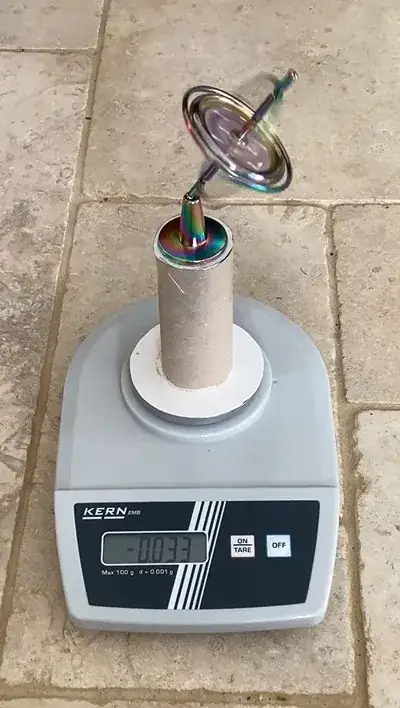I ran two tests with a toy gyroscope spinning on a weighing scale that is accurate to $1$mg. The scale was reset to zero before the tests. The gyroscope was flipped over between test $1$ and test $2$. Each test consisted of $100$ weight readings taken over roughly $20$ seconds. The readings changed rapidly so they had to be read by stepping through videos of the experiment.
There was a mean loss of weight of $10\pm 2\ $mg!
I suspended the spinning gyroscope directly over the balance tray to check if there was any downdraft that might influence the results. I didn't measure anything.
Caveat
However I must admit the instructions for the scales say “do not use balance for dynamic weighing” because of errors due to “stability compensation”.
Test 1
Standard Error Calculation
N: 100 M: -0.01 SS: 0.02 s2 = SS/(N - 1) = 0.02/(100-1) = 0 s = √s2 = √0 = 0.02 SE = s/√N = 0.02/√100 = 0
The standard error is 0.00152
Mean: -0.01g +/- 0.002
-0.012 -0.027 -0.019 -0.025 -0.021 0.000 -0.011 0.000 -0.005 -0.013 -0.011 -0.022 -0.015 -0.014 -0.011 -0.005 0.004 -0.005 0.000 -0.013 -0.014 -0.016 -0.011 0.000 -0.006 0.008 0.000 -0.017 -0.007 -0.011 -0.014 0.021 0.008 -0.009 0.005 -0.020 -0.010 -0.005 -0.030 -0.011 -0.006 0.000 -0.005 -0.020 0.000 -0.018 -0.017 -0.011 0.000 -0.019 -0.015 -0.005 0.000 -0.028 0.000 -0.032 -0.033 0.006 -0.023 0.000 -0.004 0.011 -0.026 0.006 0.005 -0.011 -0.003 0.006 0.010 -0.033 0.005 -0.025 0.007 -0.039 0.000 -0.039 -0.012 -0.009 -0.023 -0.003 0.000 -0.055 -0.029 0.000 -0.008 -0.046 0.000 -0.003 -0.007 -0.043 -0.012 0.004 -0.024 -0.008 -0.059 0.006 -0.035 0.027 0.010 -0.027
Test 2
Standard Error Calculation
N: 100 M: -0.01 SS: 0.06 s2 = SS/(N - 1) = 0.06/(100-1) = 0 s = √s2 = √0 = 0.02 SE = s/√N = 0.02/√100 = 0
The standard error is 0.00241
Mean: -0.01g +/- 0.002
-0.015 -0.018 -0.011 -0.015 0.000 -0.004 -0.003 0.007 -0.008 0.011 -0.059 -0.040 -0.012 0.000 0.005 -0.025 -0.026 0.016 0.000 -0.007 0.000 -0.028 -0.013 0.029 -0.031 -0.007 0.003 -0.028 -0.005 0.000 -0.038 -0.007 0.007 0.000 -0.040 0.000 0.013 -0.013 0.015 -0.020 -0.057 -0.011 0.026 -0.064 0.022 -0.052 0.005 -0.039 0.011 -0.042 0.000 -0.034 0.008 -0.040 0.003 -0.043 -0.047 -0.005 -0.003 -0.006 0.016 0.018 0.022 -0.047 0.016 -0.036 0.026 -0.054 0.027 -0.045 -0.055 0.012 -0.056 0.004 -0.039 -0.036 0.000 0.005 -0.047 -0.040 0.024 -0.033 0.024 0.023 -0.037 0.024 -0.018 -0.017 -0.007 0.003 -0.016 0.000 -0.020 -0.010 0.015 -0.008 0.012 0.019 -0.023 0.014
